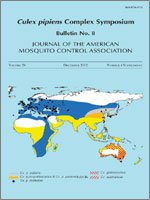Mosquitoes within the Culex pipiens complex have been implicated as major vectors of West Nile virus (WNV) in North America due to their seasonal abundance, vector competence and high field infection rates. However, the role of Cx. p. pipiens complex mosquitoes in enzootic amplification of WNV among avian hosts and epidemic transmission to humans varies throughout its geographical distribution. In the northeastern United States, Cx. p. pipiens is recognized as the primary enzootic vector responsible for amplification of virus among wild bird populations. However, because this mosquito is strongly ornithophilic, its role in transmission to humans appears to be more limited in this region. In the north central and Mid-Atlantic States by contrast, Cx. p. pipiens shows an increased affinity for human hosts and has been incriminated as a key bridge vector. In southern regions of the United States, Culex p. quinquefasciatus are more opportunistic feeders, and are thought to be principal enzootic and epidemic vectors. In western regions of the United States where Culex tarsalis predominates, especially in rural areas, Cx. p. pipiens and Cx. p. quinquefasciatus play roles that are more limited and are recognized as secondary vectors. In the southwestern United States Cx. p. quinquefasciatus also appears to be the predominant vector in urban habitats, but only a secondary vector in more rural environs. The direct involvement of Cx. p. pipiens form molestus in WNV transmission is largely unknown, but human-biting Cx. p. pipiens are more likely to have a probability of genetic ancestry with Cx. p. pipiens form molestus. The detection of WNV from overwintering populations of diapausing Cx. p. pipiens and non-diapausing Cx. p. quinquefaciatus and their role in local overwintering of WNV are addressed.
How to translate text using browser tools
1 December 2012
The Contribution of Culex pipiens Complex Mosquitoes to Transmission and Persistence of West Nile Virus in North America
Theodore G. Andreadis
ACCESS THE FULL ARTICLE
It is not available for individual sale.
This article is only available to subscribers.
It is not available for individual sale.
It is not available for individual sale.
Culex pipiens
Culex quinquefasciatus
overwintering
transmission
West Nile virus





